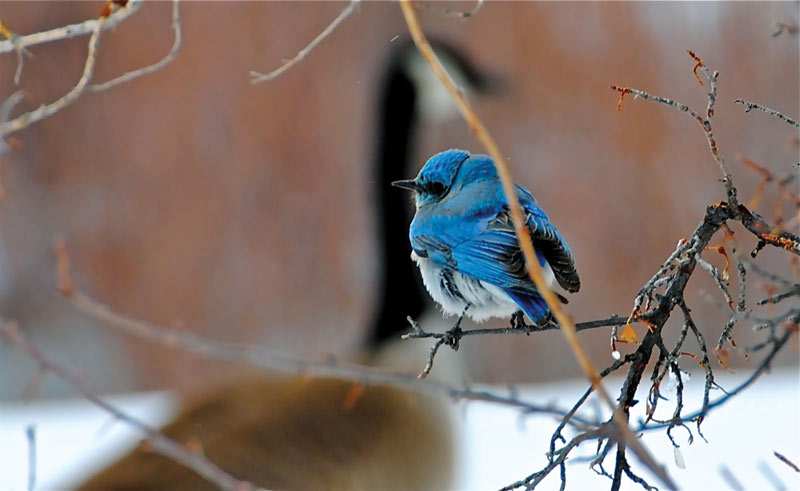
Unique to North America, all three species of bluebirds (eastern, mountain and western) are protected under the Migratory Bird Treaty Act. Photo by Pamela C. Smith
Golf courses are widely recognized for their ability to provide habitat for migratory birds, and many have embraced this role as bird sanctuaries through implementing land management strategies that promote wetlands, woodlands and other bird habitat. While golf courses have no intention of harming migratory birds, superintendents should be aware of activities and practices that could unintentionally lead to what’s known as a “take” of migratory birds protected under the Migratory Bird Treaty Act (MBTA).
In 1916, the United States and Canada recognized that human activities were causing near extinction of migratory birds whose range extended over North America. Parties entered into an agreement to safeguard these animals by ensuring the preservation of “species either harmless or beneficial to man.” The treaty required the establishment of dates for hunting migratory birds, prohibited the hunting of insectivorous birds, and allowed killing of birds only with a permit. Later amendments to the treaty included an exception for aboriginal people, authorizing them to hunt birds for food any time of year.
The U.S. Migratory Bird Treaty Act of 1918 is the domestic law, which enacted the treaty with Canada and subsequent agreements and amendments with Mexico, Russia and Japan concerning the protection of migratory birds.
Unless permitted, the MBTA makes it unlawful “by any means or in any manner, to pursue, hunt, take, capture, kill, attempt to take, capture, or kill, possess, offer for sale, sell, offer to barter, barter, offer to purchase, purchase, deliver for shipment, ship, export, import, cause to be shipped, exported, or imported, deliver for transportation, transport or cause to be transported, carry or cause to be carried, or receive for shipment, transportation, carriage, or export, any migratory bird, any part, nest, or egg of any such bird, or any product” (1).
What it means to “take” a migratory bird has a number of interpretations and varies between the different federal courts. The narrow view of “take” “covers conduct directed against wildlife” and holds that “commercial activity which may indirectly cause the death of migratory birds does not constitute a federal crime.” (This determination came in 2012, after the federal government was unsuccessful in using the MBTA to bring misdemeanor criminal charges against three oil and gas companies for the accidental deaths of migratory birds in oil pits.) The broad interpretation promoted by the U.S. Fish and Wildlife Service includes indirect and unintended conduct that results in the death of migratory birds by “any means or in any manner” (2).
As recently as 2013, the Department of Justice was enforcing the MBTA unintentional take prohibition against wind farms for the deaths of migratory birds. That year, Duke Energy, a developer of commercial-scale wind and solar energy projects, pleaded guilty to the charges regarding the losses of golden eagles and other migratory birds at two of its wind farms in Wyoming. The company agreed to pay $1 million in fines and restitution.
With more than 1,000 species of birds — from ducks to falcons to sparrows — currently protected by the MBTA, and with the willingness of the federal government to take action against the unintentional taking of migratory birds, golf course managers are wise to be alert to construction or maintenance activities that may inadvertently harm or kill these creatures. Removing trees, clearing brush and moving earth are common golf course tasks that have the potential to result in habitat destruction and unintended deaths of migratory birds, thus exposing a golf course to fines or sanctions under the MBTA.
An environmental assessment can be conducted before any construction project to identify protected and endangered species and their habitats. The assessment will determine whether there are possible impacts to migratory birds or other wildlife that will need to be addressed during the project. If the assessment does find potential for serious effects, this can then lead to further environmental impact studies, permitting and the development of detailed plans on how to mitigate the negative impacts on wildlife and habitat. There are consulting firms that specialize in conducting these environmental studies. The agency that governs fish and wildlife for your state is also a good starting point if you have questions or concerns about identifying protected wildlife on your golf course.
Sources:
1. 16 U.S. Code Annotated § 703 (a)
2. 16 U.S. Code Annotated § 703 and 707
Pamela C. Smith, CGCS, is the director of agronomy for a large city and a 25-year member of GCSAA.